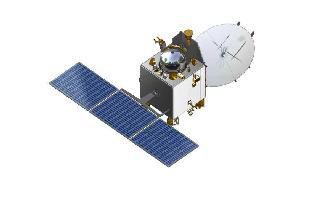Emily Lakdawalla • Jan 04, 2013
Updates on ISRO's Mars Orbiter Mission: five instruments to be delivered in March
Several news articles appeared in Indian media today about the upcoming launch of ISRO's Mars Orbiter Mission. It's the first time I've seen such detailed information about the spacecraft. There were two distinct articles appearing across numerous media outlets, so it must be a wire story or perhaps even an ISRO press release; I'm not sure how these things work in India. There isn't a release posted on ISRO's website, as far as I can find. Here's a summary of those, one printed in the Deccan Chronicle, Economic Times, Indian Express, and elsewhere, and the other posted at Parda Phash, IBN live, and other places.
The information comes out during the 100th Indian Science Congress, taking place this week in Kolkata.
- Spacecraft facts:
- Its main engine generates 440 Newtons of thrust.
- Launch mass: 1350 kg.
- It bears a single solar panel, 1.4 by 1.8 meters, producing 750W at Mars. [Note: This doesn't jibe with the single image that I have managed to find of the orbiter, posted below; that one appears to have a three-section panel, with each section possibly 1.4 by 1.8 meters. I can't explain the discrepancy.]
- For attitude control it has four reaction wheels, eight 22-Newton thrusters.
- Those are mostly pretty similar to Chandrayaan-1, except for the size of the solar panel. Chandrayaan-1 had a single 2.15-by-1.8-meter panel that generated 750W at the Moon. My guess is that the diagram below is correct and that the Mars spacecraft has a single solar array consisting of three panels 1.4 by 1.8 meters each, which would, together, manage to produce similar power at Mars that the single, larger panel did at the Moon.
- Five instruments have been selected, including:
- A color camera
- A Thermal Infrared Imaging System
- A Lyman-alpha photometer
- An Exospheric Neutral Composition Analyzer
- A Methane Sensor
- The engineering model is complete, and the flight model should be completed in March.
- ISRO expects instruments to be delivered in March for integration beginning in April.
- Launch to Earth orbit will take place "some time in October."
- The spacecraft will depart Earth orbit on November 26 and arrive at Mars on September 22, 2014.
The mission does not yet have a formal name ("Mangalyaan" is not it -- as far as I can tell, that name was made up by newspapers needing a name and following the "Chandrayaan" convention). For lack of a better one, though, I'll not change it in my previous posts until we find out what the formal name is going to be.
Jitendra Nath Goswami, director of ISRO's Physical Research Laboratory, is quoted as saying: "We are trying hard and by mid-October we are expecting to launch the Mars mission." And: "The mission has a very specific science objective as we want to study the atmosphere of Mars. This mission will explore things which have not been done previously by other countries." And: "The previous missions to Mars have shown that there was water on the planet. We would want to know how and why the planet lost water and carbon dioxide."
Although these goals sound similar to those of NASA's MAVEN, the instrument package is more general than MAVEN's -- color imaging, nighttime thermal infrared, and so on. Only the Exospheric Neutral Composition Analyzer seems to overlap with MAVEN. In any case, it's my impression that science is only a secondary goal for this mission. The primary goals are engineering ones: simply to succeed at launching a spacecraft on an Earth-to-Mars transfer orbit, successfully navigate it to Mars, successfully enter orbit at Mars, and operate it there at all would be major achievements for India, regardless of any scientific data return.
Support our core enterprises
Your support powers our mission to explore worlds, find life, and defend Earth. You make all the difference when you make a gift. Give today!
Donate

 Explore Worlds
Explore Worlds Find Life
Find Life Defend Earth
Defend Earth


